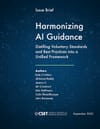⚡ Quick Summary
This CSET issue brief (Sept 2025) tackles the “too much, from everywhere” problem in AI guidance. The authors analyze 7,741 recommendations across 52 AI, security, privacy, and risk sources and harmonize them into 258 clear practices grouped into 5 categories and 34 topic areas. The result is a single, navigable framework that spans governance to incident response, shows where AI-specific guidance overlays existing controls (via an “AI Score”), and demonstrates—through quantitative validation—that comparable breadth otherwise requires stitching together ~900+ recommendations from seven frameworks. It is positioned as phase one of a three-part effort (harmonize → operationalize → tailor) to move organizations from principles to practice without drowning in documents.
🧩 What’s Covered
Problem framing. The brief diagnoses three blockers to operational AI governance: information overload, disparate sources that don’t “snap together,” and inaccessible language. It illustrates how even within NIST, teams must reconcile AI RMF, CSF, and the Privacy Framework—let alone ISO or sector playbooks.
Corpus & scope. The team compiles 7,741 recommendations from 52 documents spanning the US, UK, EU, Japan, and Singapore—29 AI-specific and 23 baseline risk/cyber/privacy frameworks—then applies mixed quantitative/qualitative methods to converge on 258 harmonized practices.
Method & validation. The harmonization process clusters recommendations, selects exemplars, and validates accuracy, representativeness, and completeness. Figure 4 demonstrates harmonized items overlaying originals across Monitoring, Risk Management, and InfoSec clusters; Figure 5 benchmarks coverage against a composite of seven reports, NIST sets, and ISO sets.
The Framework (258 → 5 categories → 34 topics). The final structure spans:
- Governance (strategy & leadership, risk, IT mgmt, supply chain, workforce, inventory, audit & compliance),
- Safety & Responsible AI (stakeholders, societal impact, impact & trust, fairness & synthetic content, test & evaluation, performance monitoring, traceability, transparency & oversight, model safeguards),
- Security (security mgmt, design & development, vulnerabilities, identity & auth, access control, network, information/endpoint, personnel/media, physical),
- Privacy (program, handling PII),
- Detection & Response (audit logging, monitoring, incident response, resilience & recovery). (See Table of Contents overview.)
AI Score. Each recommendation carries an “AI Score” indicating the degree it derives from AI-specific sources, helping teams see where “new AI” overlays “old controls.”
Coverage evidence. The harmonized 258 cover the breadth that would otherwise require ~946 recommendations from seven reports (NIST AI RMF/Playbook/CSF/Privacy, ISO 27001, CIS Controls, UK NCSC ML Principles, CLTC Taxonomy). Figure 5 on p.24 visualizes this comparison.
Roadmap. This is phase one. Next steps: (2) operationalize with concrete implementation steps and (3) tailor to use cases, echoing the NIST Playbook/profile approach and interactive toolkits (CDAO, PAI).
💡 Why it matters?
For practitioners, this collapses a fragmented standards landscape into a single, validated map, reducing translation costs and showing exactly where AI-specific novelty lives versus where existing cybersecurity/privacy/risk muscle already applies. For policymakers, it reveals how much is already expected voluntarily, helping stress-test regulation against operational reality. Most importantly, it offers a defensible way to prioritize—without reinventing governance from scratch or managing seven frameworks in parallel.
❓ What’s Missing
- Implementation depth (by design). Recommendations remain high-level; concrete “how-to” steps are deferred to phase two.
- Tailoring profiles. Sector/use-case profiles and interactive guidance are future work; today’s artifact is a unified backbone.
- Agentic AI specifics. The report flags upcoming needs around agent identity, access, and auditability—areas still thin across guidance.
- Workforce/SMB enablement detail. The problem framing highlights smaller org constraints; practical resourcing templates will matter next.
👥 Best For
- Enterprise risk, security, and privacy leaders consolidating AI, cyber, and privacy controls into one governance fabric.
- AI program owners needing a validated crosswalk to avoid duplicative framework lift.
- Policy teams & regulators benchmarking voluntary expectations before mandating obligations.
📄 Source Details
Crichton, Reddy, Ji, Crawford, Hoffmann, Shea-Blymyer, Bansemer. Harmonizing AI Guidance: Distilling Voluntary Standards and Best Practices into a Unified Framework. Center for Security and Emerging Technology (Issue Brief), September 2025. DOI: 10.51593/20240041. Licensed CC BY-NC 4.0.
📝 Thanks to
Thanks to CSET’s CyberAI Project team and reviewers acknowledged in the brief; funding support noted from the AI Safety Fund and a Google Academic Research Award.
Note: Figure 5 (p.24) visually compares the unified set’s coverage to composite/NIST/ISO baselines, underscoring breadth with fewer items. Use it when briefing executives on “why this one framework is enough to start.”


